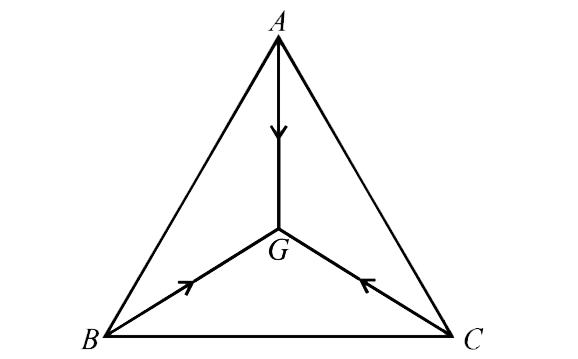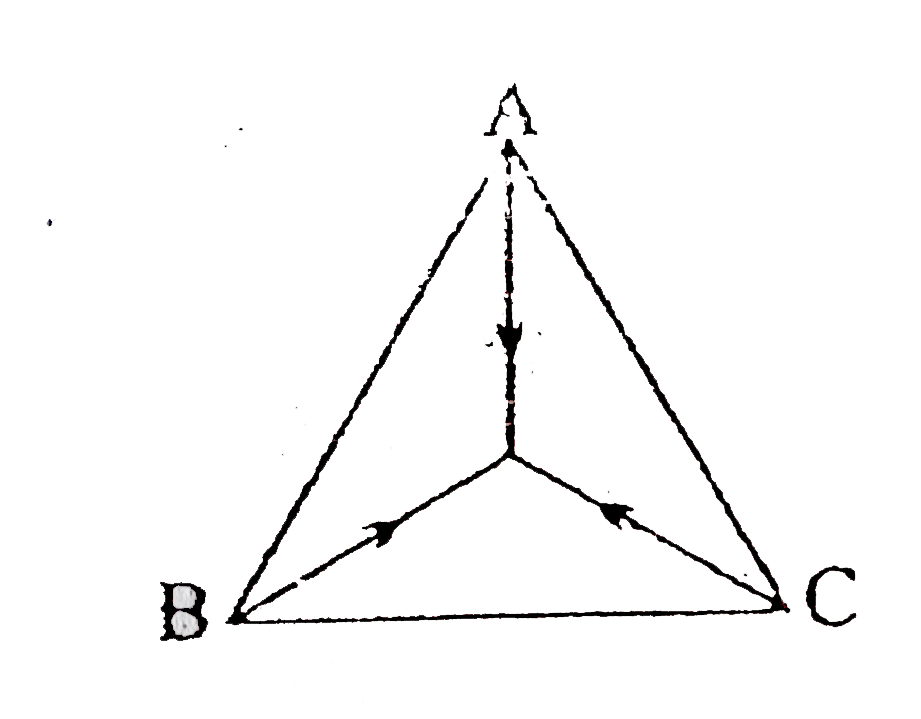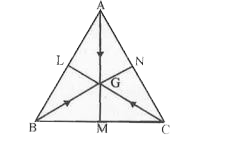Three particles each of mass m are located at the vertices of an equilateral triangle ABC. They start moving with equal speeds v each along the medians of the triangle and collide at its centroid G. If after collision A comes to rest and B retraces its path along GB then C A also comes to rest B moves with a speed v along CG C moves with a speed v along BG D moves with a speed along AG
Correct option C moves with a speed v along BGExplanation:
Related Solutions
Three particles each of mass m are located at the vertices of an equilateral triangle ABC. They start moving with equal speeds each along the medians of the triangle and collide at its centroid G. If after collision, A comes to rest and B retraces its path along GB, then C (A) also comes
View SolutionThree particles each of mass m are located at vertices of an equilateral triangle ABC. They start moving with equal speeds each along the medians of the triangle and collide at its centroid G Ifafter collision A comes to rest and B returns on its path along GB, then C
View SolutionThree particles A, B and C of equal mass move with equal speed V along the medians of an equilateral triangle as shown in hgure. They collide at the centroid G of the triangle. After the collision, A comes to test, B retraces its path with the speed V. What is the velocity of C ?

View SolutionThree particles A, B and C of equal mass move with equal speed V = 5 ms^(-1) along the medians of an equilateral triangle as shown in the figure. They collide at the centroid G of the triangle. After the collision, A comes to rest, B retraces its path with the speed V = 5 ms^(-1) . What is the speed of C ?
View SolutionThree particles and of equal mass move with equal speed along the medians of an equilateral triangle as shown in the figure. They collide at the centroid of the triangle. After the collision, comes to rest, retraces its path with the speed . What is the speed of ?

View SolutionThree particles A, B, C, of equal masses move with equal speed V along -the medians of an equiliteral triangle as shown in the diagram below. They collide at the centroid G of the triangle. After the collision A comes to rest, B retraces its path with speed V. What is the velocity of C ?
View SolutionThree particles A, B and C of equal mass move with equal speed V along the medians of an equilateral triangle as shown in hgure. They collide at the centroid G of the triangle. After the collision, A comes to test, B retraces its path with the speed V. What is the velocity of C ?
View SolutionThree particles A, B and C of equal mass move with equal speed V along the medians of an equilateral triangle as shown in hgure. They collide at the centroid G of the triangle. After the collision, A comes to test, B retraces its path with the speed V. What is the velocity of C ?
View SolutionThree particles A, B and C of equal mass move with equal speed 10 m/sec along the medians of an equilateral triangle as shown in the figure. They collide at the centroid G of the triangle. After the collision, A comes to rest, B retraces its path with the speed 10 m/sec. The velocity of C is _______ m/sec.
View SolutionThree particles with equal mass move with equal speed v along the medians of an equilateral triangle as shown. They all collide at the centroid simultaneously. After the collision. A comes to rest, B retraces it's path with same speed. What is speed of C after the collision?
View SolutionThree particles with equal mass move with equal speed along the medians of an equilateral triangle as shown. They all collide at the centroid simultaneously. After the collision. comes to rest, retraces it's path with same speed. What is speed of after the collision?

View SolutionThree particles A, B and C of equal masses, moving with the same speed 'v' along the medians of an equilateral triangle, collide at the centroid G of the triangle. After collision, A comes to rest B retraces its path with a speed 'v'. The speed of C after the collision is

View SolutionThree identical particles are located at the vertices of an equilateral triangle. Each particle moves along a meridian with equal speed towards the centroid and collides inelastically.
View SolutionThree particles A, B and C are situated at the vertices of an equilateral triangle ABC of side d at time Each of the particles moves with constant speed v. A always has its velocity along AB, B along BC and C along CA. At what time will the particles meet each other?
View SolutionThree particles A, B and C are situated at the vertices of an equilateral triangle ABC of side d at time Each of the particles moves with constant speed v. A always has its velocity along AB, B along BC and C along CA. At what time will the particles meet each other?
View SolutionThree particles A, B and C are situated at the vertices of an equilateral triangle ABC of side d at time Each of the particles moves with constant speed v. A always has its velocity along AB, B along BC and C along CA. At what time will the particles meet each other?
View SolutionThree particles A, B and C are situated at the vertices of an equilateral triangle ABC of side d at time Each of the particles moves with constant speed v. A always has its velocity along AB, B along BC and C along CA. At what time will the particles meet each other?
View Solutionसमान द्रव्यमान के तीन कण A, B व C चित्र के अनुसार एक समबाहु त्रिभुज की माध्यिकाओं के अनुदिश समान चाल v से चलते हैं। ये त्रिभुज के केन्द्र G पर टकराते हैं। टकराने के पश्चात् Aस्थिर हो जाता है तथा Bउसी चाल से वापस लौटता है। C का वेग क्या है?

View SolutionA ball of mass m moving with a velocity v along X-axis, strikes another ball of mass 2m kept at rest. The first ball comes to rest after collision and the other breaks into two equal pieces. One of the pieces starts moving along Y-axis with a speed . what will be the velocity of the other piece?
View SolutionA ball of mass m moving with a velocity v along X-axis, strikes another ball of mass 2m kept at rest. The first ball comes to rest after collision and the other breaks into two equal pieces. One of the pieces starts moving along Y-axis with a speed . what will be the velocity of the other piece?
View Solution